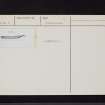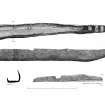Following the launch of trove.scot in February 2025 we are now planning the retiral of some of our webservices. Canmore will be switched off on 24th June 2025. Information about the closure can be found on the HES website: Retiral of HES web services | Historic Environment Scotland
Loch Arthur
Paddle (Period Unassigned)(Possible), Logboat (Period Unassigned)
Site Name Loch Arthur
Classification Paddle (Period Unassigned)(Possible), Logboat (Period Unassigned)
Alternative Name(s) Loch Lotus; Lotus Loch; Loch Arthur 1
Canmore ID 65470
Site Number NX96NW 3
NGR NX 905 687
NGR Description NX c. 905 687
Datum OSGB36 - NGR
Permalink http://canmore.org.uk/site/65470
- Council Dumfries And Galloway
- Parish New Abbey
- Former Region Dumfries And Galloway
- Former District Nithsdale
- Former County Kirkcudbrightshire
NX96NW 3 c. 905 687
For Loch Arthur 2 logboat (NX 9028 6898), see NX96NW 1.
(Approx: NX 902 687) An oak dug-out canoe, 45 ft long and up to 5 ft in width, was found in 1874 at Loch Arthur (Lotus Loch) on the opposite side of the loch to, and 300 to 400 yds from, the crannog side of the loch to, and 300 to 400 yds from, the crannog described on NX96NW 1. The canoe was damaged during removal, and the bow half, including an animal's head prow was donated to the National Museum of Antiquities of Scotland (NMAS: Accession no: IN 3). The more broken stern portion went to Dumfries Museum, and nothing identifiable now remains of it.
A model of the canoe as originally found was also donated to the NMAS but cannot now be traced (information from A S Henshall, NMAS, 11 August 1964).
J E Gillespie 1876; J K Hewison 1939; J Williams 1971.
A radio-carbon date of 101 BC +/- 80 has been obtained for this canoe; a tree-ring count from the point sampled to the outside of the trunk adds 80 years, while outer wood removed when the canoe was made represents perhaps 50 years or so. Thus the canoe was built about AD 30 + 80.
J Close-Brooks 1977.
(Loch Arthur 1; location amended to NX c. 905 687). In July 1874 a logboat was revealed near the S shore of Loch Arthur when the water level was abnormally low. This loch (which was formerly known as Loch Lotus or Lotus Loch) is situated on the NW flank of the Criffel massif at an altitude of about 75m OD. Three bronze tripod-vessels had previously been found in the loch, and near the N shore there is a crannog.
Recovery of the logboat was achieved with 'some damage' to the sides and it was subsequently allowed to deteriorate in the open air while suffering the depredations of visitors. The stern portion (which was the worse affected) was discarded but the forward portion is in store at the Royal Museum of Scotland under accession number NMS IN 3. The short length of a possible paddle-handle that was found in the logboat was also lost; it measured about 2" (51mm) in diameter and the end of it was decorated with carved beading.
The boat was recorded independently by Gillespie and Hewison. It was worked from 'oak' and measured 45' (13.7m) in length over all, and 5' (1.5m) in beam at the stern, which was formed by a transom inserted into a groove about 1?" (38mm) from the extremity. Along the starboard side there survived seven holes measuring about 3" (76mm) in diameter regularly spaced at intervals of about 5' (1.5m). The bottom was pierced by three irregularly-spaced thickness-gauge holes.
The surviving portion of the boat measures 6.34m in length to the point where it has been sawn off, at which point it measures 0.7m in breadth. The starboard side survives to a height of 0.43m internally and the boat has had an extremely high ratio of length to beam. The remains have not suffered greatly from splitting, but gross warping has displaced the bow section to port. There are possible toolmarks in the exterior of the starboard side and among the numerous knot-holes there are four thickness-gauge holes which are set vertically at irregular intervals close to the rounded junctions of the bottom with the sides. These measure between 35mm by 35mm and 60mm by 40mm and penetrate the bottom which varies between 70mm and 100mm in thickness.
The bow of the boat was recognised to have an unusual elongated form terminating in a 'remarkable prolongation resembling the outstretched neck and head of an animal'. This feature is roughly paralleled in the logboats Errol 2 (NO22SE 4) and Loch of Kinnordy (NO35SE 12), and is similarly to be explained as probably fortuitous. The hole that forms the 'eye' measures about 5" (127mm) in diameter and is probably intended to receive a painter or boatrope.
The jagged hole on the port side and the broken section on the starboard are joined by a section of wood which has probably been smoothed, possibly also to hold a rope.
The acutely-angled bow section is also remarkable for the internal 'steps' that have probably been left as a simple strengthening device. These have no apparent Scottish comparanda but are paralleled in three boats from Holme Pierrepont, Nottingham, England, one of which has been dated by radiocarbon to 230 ? 110 bc.
At or near the upper surfaces of the (more complete) starboard side there are two prominent depressions and a hole which measures 90mm by 67mm and is set 30mm below the top of the surviving side at a point where the timber is about 30mm thick. The function of the these features is unclear but they may have served as handholds for portage in spite of the considerable weight of the boat; they were presumably duplicated on the port side.
Stored with this logboat, but having no specific accession number or records, there is a piece of timber measuring 2.88m in length which has formed the stern portion of the lower starboard side of a logboat and the adjoining section of the bottom; in the top side there is one deep depression and part of a second. Part of a transom-groove measuring about 25mm in width and 18mm in depth is to be seen and has probably been cut with a metal chisel. Although the timber of this fragment is finer-grained and more heavily knotted than the main section of the boat, the presence of the depressions and of the transom groove make it probable that this fragment has formed part of the same boat.
On the basis of the best available measurements, the slenderness coefficient of this vessel was 9, the beam/draught coefficient was 3 and the displacement under standard conditions about 18.8 cubic metres. This was without doubt a very large logboat by Scottish standards, having speed potential, manoeuvrability and ample capacity for bulky cargo. The McGrail morphology code is 44a3:3x4:331 and the form dissimilar-ended.
This logboat has been radiocarbon-dated to 101 ? 80 bc (SRR-403) although the location of the sample makes this date erroneously early. The determination may be calibrated to about 75 cal BC, and the vessel should probably be dated within the last century and a half BC and the first two centuries AD.
PSAS 1876; J E Gillespie 1876; J K Hewison 1939; J Close-Brooks 1975; S McGrail 1987; R J C Mowat 1996, visited August 1987.












